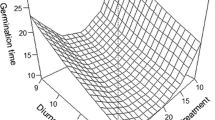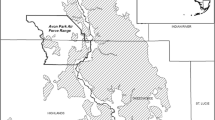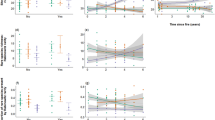Abstract
The relationships between rarity (i.e., range-size, local abundance) and niche-breadth can be important to assess the risks the species face under global change, namely those resulting from fire regime change. In fire areas, germination is critical for establishing after fire for many species. We examined the relationships between rarity and germination niche-breadth for 53 plant species of two life-forms (chamaephytes and hemicryptophytes) growing in Eastern Spain. Rarity was measured as geographic range-size and as local abundance. Local abundance was evaluated at two sites differing in their post-fire successional status (a recently burned area and a long-unburned one). Germination niche-breadth was measured as the mean germination evenness index from four germination experiments that subjected the seeds to various germinating conditions characteristics of fire environments. Correlations between rarity (range-size, local abundance) and niche-breadth were calculated in cross-species mode or by way of phylogenetically independent contrasts, and either for the 53 species (all-species set) or for each of two life-form groups (chamaephytes, hemicryptophytes). In general, no significant correlations were found between the rarity measures and germination niche-breadth for the all-species set. However, significant correlations emerged when the analyses were done separating species by life-forms. Germination niche-breadth was positively correlated with range-size for chamaephytes, and negatively for hemicryptophytes. In addition, germination niche-breadth was uncorrelated, or negatively so, with local abundance for chamaephytes and hemicryptophytes, respectively. While no correlation between range-size and local abundance was found for chamaephytes, a negative one was obtained for hemicryptophytes. We conclude that rarity/germination-niche relationships varied by life-form. This pattern of relationships was obscured when all species were joined in a single group. Based on the contrasting patterns of correlations obtained for each life-form we argue that the changes in the germinating environment caused by alterations in fire regime are likely to differentially affect these two groups of species.
Similar content being viewed by others
References
Baskin CC, Baskin JM (1988) Germination ecophysiology of herbaceous plant species in a temperate region. Am J Bot 75:286–305
Bolós O, Vigo J (1984–2001) Flora dels Països Catalans. Pòrtic, Barcelona
Brändle M, Stadler J, Klotz S, Brandl R (2003) Distributional range-size of weedy plant species is correlated to germination patterns. Ecology 84:136–144
Brown JH (1984) On the relationship between abundance and distribution of species. Am Nat 124:255–279
Carvalho P, Felizola Diniz-Filho JA, Bini LM (2006) Factors influencing changes in trait correlations across species after using phylogenetic independent contrasts. Evol Ecol 20:591–602
Colwell RK, Futuyma FJ (1971) On measurement of niche breadth and overlap. Ecology 52:567–576
Davies TJ, Barraclough TG, Chase MW, Soltis PS, Soltis DE, Savolainen V (2004) Darwin’s abominable mystery: insights from a supertree of the angiosperms. PNAS 101:1904–1909
Felsenstein J (1985) Phylogenies and the comparative method. Am Nat 125:1–15
Gaston KJ (1994) Rarity. Chapman and Hall, London
Gaston KJ, Blackburn TM (2000) Pattern and process in macroecology. Blackwell Science, Oxford
Grubb PJ (1977) The maintenance of species richness in plant communities, the importance of regeneration niche. Biol Rev 52:53–76
Guo Q (2001) Early post-fire succession in California chaparral: changes in diversity, density, cover and biomass. Ecol Res 16:471–485
Gutterman Y (2000) Maternal effects on seeds during development. In: Fenner M (ed) Seeds: the ecology of regeneration in plant communities. CABI Publishing, Wallingford, pp 59–82
Hendry GAF, Grime JP (1993) Methods in comparative plant ecology. A laboratory manual. Chapman and Hall, London
Houssard C, Escarré J, Romane F (1980) Development of species diversity in some Mediterranean plant communities. Vegetatio 43:59–72
Hutchinson GE (1965) The ecological theatre and the evolution play. Yale University Press, New Haven
Johnson CN (1998) Species extinction and the relationship between distribution and abundance. Nature 394:272–274
Kazanis D, Arianoutsou M (1996) Vegetation composition in a post-fire successional gradient of Pinus halepensis forests in Attica, Greece. Int J Wild Fire 6:83–91
Keeley JE, Fotheringham CJ, Baer-Keeley M (2005) Determinants of postfire recovery and succession in Mediterranean-climate shrublands of California. Ecol Appl 15:1515–1534
Kelly CK, Woodward FI (1996) Ecological correlates of plant range-size, taxonomies and phylogenies in the study of plant commonness and rarity in Great Britain. Philos T R Soc B 351:1261–1269
Köckemann B, Buschmann H, Leuschner C (2009) The relationships between abundance, range size and niche breadth in Central European tree species. J Biogeogr 36:854–864
Kutiel P (1997) Spatial and temporal heterogeneity of species diversity in a Mediterranean ecosystem following fire. Int J Wild Fire 7:307–315
Lavorel S, McIntyre S, Landsberg J, Forbes TDA (1997) Plant functional classifications: from general groups to specific groups based on response to disturbance. TREE 12:474–478
Luna B, Moreno JM (2009) Light and nitrate effects on seed germination of Mediterranean plant species of several functional groups. Plant Ecol 203:123–135
Luna B, Moreno JM, Cruz A, Fernández-González F (2007) Heat-shock and seed germination of a group of Mediterranean plant species growing in a burned area: an approach based on plant functional types. Environ Exp Bot 60:324–333
Luna B, Pérez B, Céspedes B, Moreno JM (2008) Effect of cold-exposure on seed germination of 58 plant species comprising several functional groups from a mid-mountain Mediterranean area. Écoscience 15:474–484
Médail F, Quézel P (1999) Biodiversity hotspots in the Mediterranean basin: setting global conservation priorities. Conserv Biol 13:1510–1513
Melendo M, Giménez E, Cano E, Gómez-Mercado F, Valle F (2003) The endemic flora in the south of the Iberian Peninsula: taxonomic composition, biological spectrum, pollination, reproductive mode and dispersal. Flora 198:260–276
Metzger MJ, Rounsevell MDA, Acosta-Michlik L, Leemans R, Schröter D (2006) The vulnerability of ecosystem services to land use change. Agr Ecosyst Environ 114:69–85
Moreno JM, Vázquez A, Vélez R (1998) Rencent history of forest fires in Spain. In: Moreno JM (ed) Large forest fires. Backhuys Publishers, Leiden, NL, pp 159–185
Moreno JM, Zavala G, Martín M, Millán A (2010) Forest fire risk in Spain under future climate change. In: Settele J, Kühn I (eds) Atlas of biodiversity risks—from Europe to the globe, from stories to Maps (in press)
Moriondo M, Good P, Durao R, Bindi M, Giannakopoulos C, Corte-Real J (2006) Potential impact of climate change on fire risk in the Mediterranean area. Clim Res 31:85–95
Pausas JG, Keeley JE (2009) A burning story: the role of fire in the history of life. Bioscience 59:593–601
Pausas JG, Lloret J, Rodrigo A, Vallejo R (2008) Are wildfires a disaster in the Mediterranean basin?—a review. Int J Wildland Fire 17:713–723
Purvis A, Rambaut A (1995) Comparative analysis by independent contrasts (CAIC), an Apple Macintosh application for analysing comparative data. Comp Appl Biosci 11:247–251
Raunkiaer C (1934) The life forms of plants and statistical plant geography. Clarendon, Oxford
Soriano LR, de Pablo F, Díez EG (2001) Cloud-to-ground lightning activity in the Iberian Peninsula: 1992–1994. J Geophys Res 106:11891–11901
Stevens GC (1989) The latitudinal gradient in geographical range, how so many species coexist in the tropics. Am Nat 133:240–256
Syphard AD, Radeloff VC, Hawbaker TJ, Stewart SI (2009) Conservation threat due to human-caused increases in fire frequency in Mediterranean-climate ecosystems. Conserv Biol 23:758–769
Tatoni T, Roche P (1994) Comparison of old-filed and forest revegetation dynamics in Provence. J Veg Sci 5:295–302
Thompson K, Ceriani RM (2003) No relationship between range-size and germination niche in the UK herbaceous flora. Func Ecol 17:335–339
Thompson K, Gaston KJ, Band S (1999) Range-size, dispersal and niche breadth in the herbaceous flora of central England. J Ecol 87:150–155
Thuiller W, Albert C, Araujo MB, Berry PM, Cabeza M, Guisan A, Hickler T, Midgely GF, Paterson J, Schurr FM, Sykes MT, Zimmermann NE (2008) Predicting global change impacts on plant species’ distributions: future challenges. Perspect Plant Ecol 9:137–152
Trabaud L (1994) The role of fire in ecological systems. SPB Academic Publishing, The Hague, Netherlands
Vázquez A, Moreno JM (1998) Patterns of lightning-, and people-caused fires in peninsular Spain. Int J Wildland Fire 8:103–115
Verlaque R, Médail F, Aboucaya A (2001) Valeur prédictive des types biologiques pour la conservation de la flore méditerranéenne. CR Biol 324:1157–1165
Acknowledgements
This research was supported by the European Commission (EVG1-CT-2001-00043) and by the Spanish CICYT (CGL2006-06974. We thank Kevin J. Gaston and Christopher Lortie for their helpful comments.
Author information
Authors and Affiliations
Corresponding author
Rights and permissions
About this article
Cite this article
Luna, B., Moreno, J.M. Range-size, local abundance and germination niche-breadth in Mediterranean plants of two life-forms. Plant Ecol 210, 85–95 (2010). https://doi.org/10.1007/s11258-010-9740-y
Received:
Accepted:
Published:
Issue Date:
DOI: https://doi.org/10.1007/s11258-010-9740-y




